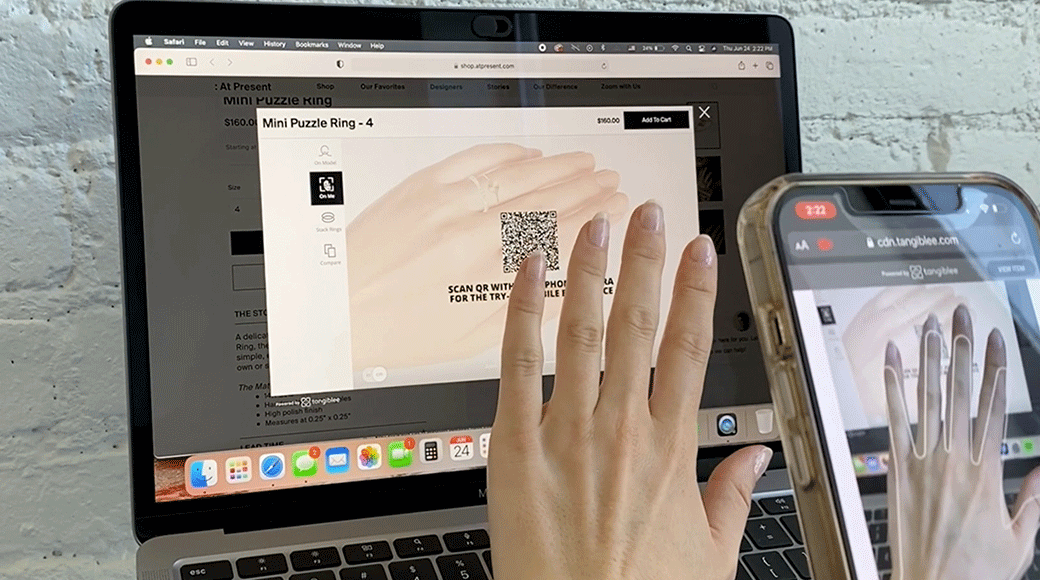
Exploring the Evolution of Augmented Reality in eCommerce
The concept of augmented reality (AR) technology may seem new, but it’s not a new technology by any means.
The first AR experience was created in 1957 after cinematographer Morton Heilig developed a bizarre invention — the Sensorama — to blend sound, visuals, vibration, and scent into one, complete experience.
Thankfully, despite AR’s strange beginning, there have been multiple attempts to develop modern AR solutions, as well as it’s more advanced cousin virtual reality, into something practical and tangible.
So, where is AR technology today?
Augmented reality has changed how we shop, completely redefining the eCommerce experience. But how did we get here? What was it that caused AR technology to evolve from oversized electronics and bizarre scent booths into a powerful platform for customers and merchants alike?
To answer that, we’re going to need to go back a few years to when augmented reality first started making waves in online shopping.
It All Started With a Game
For decades, augmented reality was viewed as little more than a novelty. Some early adopters recognized the technology’s commercial potential, certainly. In 2008, for instance, automaker BMW became one of the first companies in the world to use AR in its marketing.
Yet for every forward-thinking project like BMW’s print ads, there were failures like the ill-fated Google Glass, released in 2013 and still regarded as one of the biggest product failures of all time.
For a time, it seemed as though blunders like that would forevermore be the face of augmented reality. People, after all, tend to have remarkably long memories when it comes to failures. Success, not so much.
Then in 2016, mobile developer Niantic released Pokémon GO.
How Pokémon Demonstrated the Commercial Potential of AR
You’d be hard pressed to find someone that doesn’t remember the excitement and enthusiasm surrounding Pokémon GO in the years immediately following its release. By 2017, the game had 65 million monthly players, and had been downloaded approximately 750 million times.
The media was filled with stories about the game. How it functionally took over the world, creating a sense of unity and community not seen in decades. How, in the wake of the game’s release, Nintendo’s stock nearly doubled. And, perhaps most interestingly, how it inspired its own cottage industry.
Businesses such as restaurants and cafes endeavored to be added to the app as gyms or pokestops in the hopes of attracting more customers. Map tools, chat apps, and branded smart devices and chargers began selling like wildfire. As of 2021, the game has made a total of $5 billion since release.
If anyone was looking for proof that augmented reality was commercially and financially viable, Pokémon GO was it. Yet even as Niantic’s software drew attention from countless businesses, its potential in the eCommerce sector remained unexplored for most. What was it, then, that truly tipped the scales and created a surge of interest in digital retail AR for consumers and merchants alike?
You probably already know the answer. The same thing that has, for the past two years, redefined how we live, work, and exist. COVID-19.
A Fully Remote Retail Experience
In just three months, eCommerce retailers all but replaced physical channels — something which analyst McKinsey notes is equivalent to a full decade of market growth. At the same time, in a 2021 survey by Deloitte and Snap, more than half of people indicated that augmented reality has become more important to them since the pandemic began. These factors together effectively created a perfect storm.
As people worked from home and socially isolated during lockdown, many sought out retailers capable of providing them with at least an approximation of an in-store experience. Though there was no substitute for examining a product with their own hands, they at least wanted something more than static product photos. Even in 2019, before the pandemic struck, 71% of people admitted that they would shop more often with a retailer that offered AR.
This has only been amplified during the pandemic, with some retailers seeing as much as a 200% increase in sales after incorporating AR.
For Tangiblee, these facts and figures do not come as any great surprise. Since progressing through seed accelerator TechStar in 2014, we have sought to redefine how both retailers sell and how customers shop. Over the years, we’ve watched eCommerce evolve from a burgeoning market into one of the most important industries in the world.
And we’re excited to play a pivotal role in that evolution.
Tangiblee Makes Creating Interactive Shopping Experiences Easy
Today, we’re partnered with some of the top online retailers, empowering them with a scalable, adaptable, and effective customer experience platform designed for customer engagement and immersion.
Intuitive and resource-light, our platform processes 5,000 SKUs a day. And through our advanced technology, we offer everything from customizable lifestyle content, live product comparisons, and a “virtual try-on” feature to create truly personalized experiences.
Augmented reality has come a very long way from its humble origins, particularly with the boost in popularity it gained from the pandemic.
Are you looking for a powerful AR solution to enhance your shopping experience?
Book a demo and see how Tangiblee can become your conversion-boosting differentiator.
This content was originally published here.


